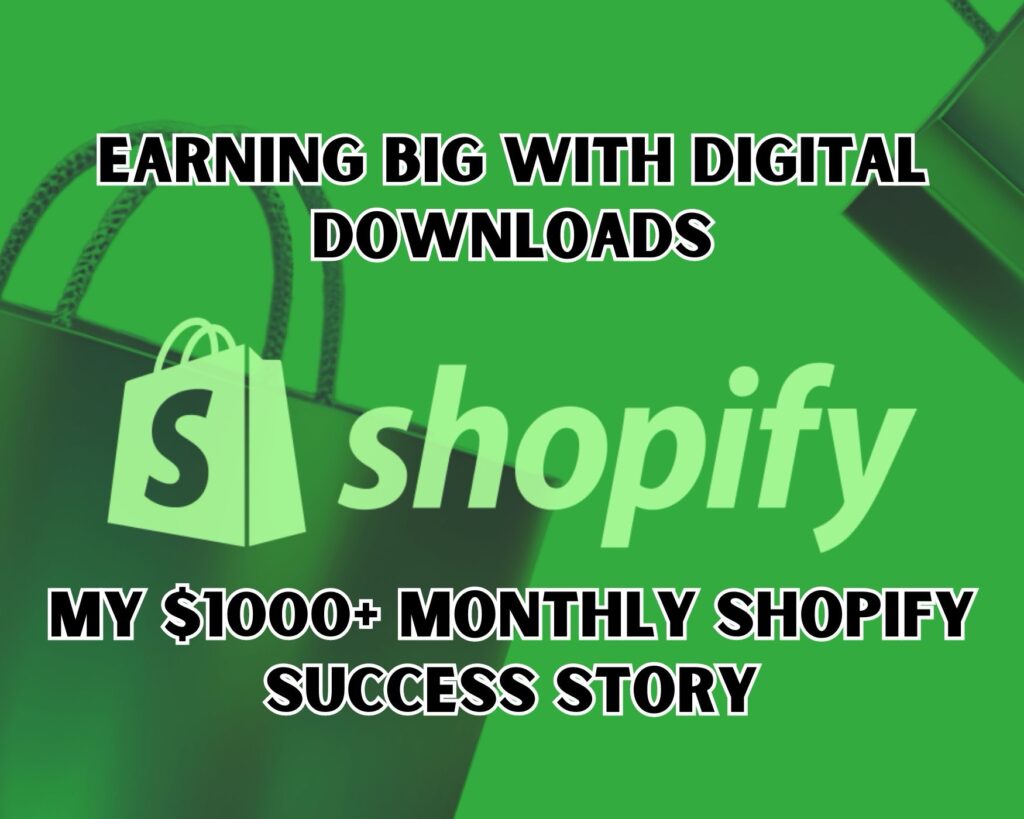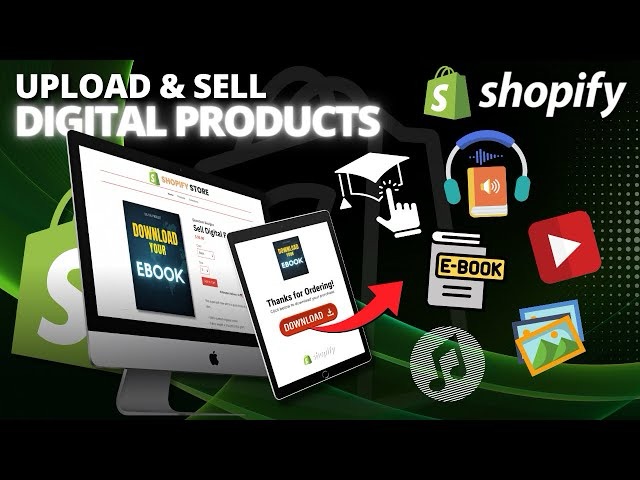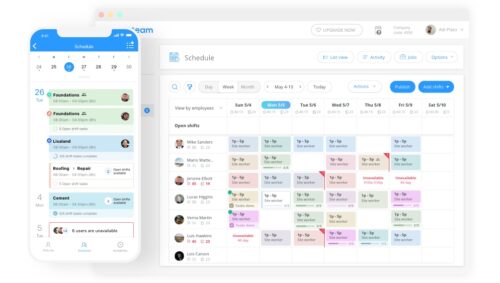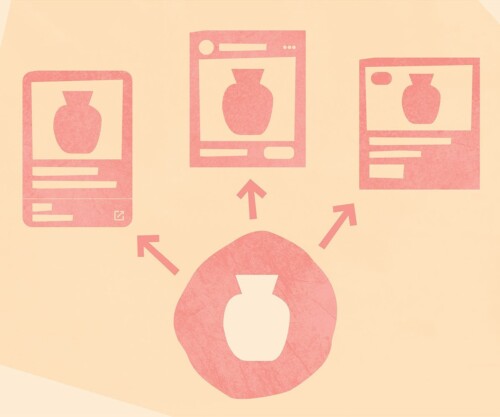When I first stumbled upon the idea of selling digital products on Shopify, I was cautiously optimistic. Like many of you, I was on the lookout for a side hustle that could eventually turn into a substantial stream of income. The digital landscape always fascinated me, with its boundless opportunities and the promise of connecting with customers worldwide. Fast forward to today, and I’m consistently earning over $1000 a month by selling digital downloads on Shopify. This journey from skepticism to success wasn’t overnight, but it was undoubtedly worth the effort. You can sign up to get Shopify here today!

The beauty of digital products lies in their versatility and the low overhead required to get started. Whether you’re a creator at heart or someone with valuable knowledge to share, the digital product space offers a canvas limited only by your imagination. From eBooks and online courses to software and art, the possibilities are endless. But what truly set the stage for my success was Shopify—a platform that made it incredibly easy to set up a store, showcase my products, and reach customers eager to purchase what I had to offer.
In this article, I’ll take you through my journey of making over $1000 a month by selling digital products. I’ll share insights into setting up your Shopify store, generating product ideas, creating and marketing your products, and ultimately scaling your business. Whether you’re new to the digital product scene or looking to optimize your current strategy, my story aims to inspire and guide you towards achieving your financial goals through Shopify. Let’s dive into the world of digital downloads and uncover the potential for substantial earnings, one digital product at a time.
Understanding the Digital Product Landscape
Embarking on my Shopify journey, the first step was understanding what digital products were and the potential they held. Digital products are items you can sell and distribute online without needing physical inventory. This aspect was particularly appealing because it meant low overhead costs and the ability to automate much of the selling process. The beauty of digital products is their diversity and scalability. Once created, they can be sold to an unlimited number of customers without additional production costs.
Types of Digital Products
The digital product landscape is vast, offering numerous avenues to explore based on your skills, interests, and market demand. Here are some of the digital product ideas that caught my attention:
- eBooks: An excellent way for writers to share their expertise or stories. I noticed a high demand for both non-fiction how-to guides and fiction narratives.
- Online Courses and Webinars: With my background in digital marketing, creating instructional content seemed like a natural fit. There’s a significant audience eager to learn new skills online.
- Software and Apps: While I’m not a developer, the potential to collaborate with one to create useful tools or entertaining apps was intriguing.
- Music and Audio Files: As a hobbyist musician, the idea of selling my compositions or sound effects online was exciting.
- Photography and Art: Selling digital prints, illustrations, and design templates can be a lucrative avenue for visually creative individuals.
- Documents and Templates: Recognizing a need for professional templates (like resumes or business plans) highlighted another potential product niche.
Benefits of Selling Digital Products
The advantages of selling digital products became clear early on:
- Low Overhead Costs: No need for physical inventory or shipping logistics.
- Global Market: The ability to reach customers around the world 24/7.
- Passive Income Potential: After the initial creation and setup, sales can be made while you sleep.
- Scalability: Easy to expand your product line without significant additional expenses.
Understanding the digital product landscape laid the foundation for my Shopify store. It was time to move from concept to creation, leveraging my skills and interests to tap into the thriving market of digital downloads. This exploration phase was crucial in identifying which products I was passionate about and which had the potential to generate consistent monthly income.

Setting Up Your Shopify Store
Once I had a solid grasp of the digital product landscape, the next logical step was setting up my Shopify store. Shopify’s user-friendly interface made this process surprisingly straightforward, even for someone with minimal technical expertise. My goal was to create a store that not only looked professional but also reflected the digital products I was planning to sell. Here’s how I went about it:
Choosing the Right Theme
Shopify offers a variety of themes, some free and others paid, designed to cater to different aesthetics and functional needs. I spent time browsing through the theme store, prioritizing responsiveness and ease of navigation. My advice? Choose a theme that aligns with the digital products you’re selling. For example, a clean, minimalist theme works well for selling eBooks or courses, while a more vibrant and visual theme might suit an art or photography store.
Customizing Your Store
Customization was key in making my store stand out. Shopify’s customization options allowed me to adjust colors, fonts, and layouts to match my brand identity. I added high-quality images related to my digital products and crafted compelling product descriptions that highlighted the benefits and features of each item. Remember, the goal is to make your products irresistible to potential buyers.
Adding Digital Products
Shopify makes it easy to add products to your store. For digital products, I used apps like Digital Downloads (by Shopify) or third-party apps like SendOwl to handle the delivery of products after purchase. These apps automate the process, sending customers a download link upon payment. It’s crucial to ensure that the delivery process is seamless, as this enhances customer satisfaction and trust.
Setting Up Payments and Policies
I set up various payment methods to offer flexibility to my customers, including credit cards and PayPal. Shopify supports multiple payment gateways, making it easy to integrate the ones that work best for your target market. Additionally, I created clear, concise policies for refunds, privacy, and terms of service to build trust and ensure compliance with legal requirements.
Launching the Store
Before launching, I did a thorough review of the store, testing the purchasing process, download links, and customer notifications. Feedback from friends and family also provided valuable insights that helped fine-tune the user experience. Once satisfied, I officially launched my Shopify store, ready to welcome my first customers.
Setting up the Shopify store was a pivotal moment in my journey. It marked the transition from idea to action, bringing me closer to achieving my goal of earning over $1000 a month. For those interested in exploring the potential of digital products further, whether in eCommerce or other entrepreneurial ventures, 🌟 Rich Money Mind 🌟 offers inspiring insights into the empires built by some of the wealthiest Americans. Their stories underline the importance of innovation, perseverance, and strategic thinking in building a successful business.

Product Ideas to Kickstart Your Business
With my Shopify store set up and ready to go, I shifted my focus to what I would sell. The digital product landscape is rich with opportunities, and choosing the right products is crucial for success. Here are some of the digital product ideas that not only inspired me but also have the potential to generate significant income.
eBooks
Writing and selling eBooks can be a fantastic way to share knowledge or stories with the world. Whether it’s a comprehensive guide on a niche topic or a captivating novel, eBooks have a broad market. The key is to find a subject you’re passionate about or possess expertise in, ensuring your content provides value to your readers.
Online Courses and Webinars
Leveraging your expertise by creating online courses or webinars can be incredibly lucrative. The demand for online learning has skyrocketed, with people eager to acquire new skills from the comfort of their homes. Structuring your knowledge into digestible modules and using engaging teaching methods can set your courses apart.
Software and Apps
If you have a knack for technology, developing software, tools, plugins, or mobile apps can be a goldmine. The digital world is always on the lookout for innovative solutions to everyday problems. Whether it’s a productivity tool or an entertaining app, the potential for success is vast.
Music and Audio Files
For the musically inclined, selling songs, sound effects, or audiobooks opens up another avenue for digital product sales. High-quality, original audio content is in demand across various platforms, from video production to podcasting.
Photography and Art
Digital prints, illustrations, and graphic design templates cater to a wide audience, from businesses to individuals looking for unique artwork. The key is to create visually appealing, high-resolution images that capture the imagination of your potential customers.
Documents and Templates
Professional templates for resumes, business plans, or financial spreadsheets save time and provide immense value to users. By creating well-designed, customizable templates, you can cater to a niche market seeking to enhance their professional or personal projects.
Each of these product ideas has the potential to be transformed into a passive income stream, echoing the stories of successful entrepreneurs who have mastered the art of 🌟 earning in their sleep 🌟. From leveraging your expertise to tapping into your creative talents, the opportunities for creating digital products that sell are endless. The key is to identify a niche you’re passionate about and explore innovative ideas that meet a specific need or desire. Stop kicking around the idea and waiting, start your Shopify store here!

Creating Your Digital Products
Having settled on the types of digital products I wanted to offer, the next step was creating these products. This phase was both exciting and challenging, as it involved translating my ideas into tangible, sellable digital goods. Here’s how I approached the creation process, ensuring my products were not only high quality but also appealing to my target audience.
Focus on Quality and Value
The cornerstone of successful digital products is the value they offer to customers. Whether it was an eBook or an online course, I made sure to pack each product with actionable insights, expert knowledge, or captivating narratives. For software or apps, functionality and user experience were my top priorities. High-quality, valuable content leads to satisfied customers and positive reviews, which are crucial for long-term success.
Utilize the Right Tools and Resources
The creation of digital products requires the right tools and resources. For eBooks and documents, I used word processors like Microsoft Word or Google Docs, coupled with design software such as Adobe InDesign for layout and formatting. For online courses, video editing software like Adobe Premiere Pro and a reliable hosting platform were essential. Choosing the right tools streamlined the production process, making it more efficient and enjoyable.
Packaging Your Products
Presentation matters. I invested time in designing appealing cover art for eBooks and engaging thumbnails for courses. For software and apps, a clean, intuitive interface was a must. The packaging of your digital product not only enhances its appeal but also communicates its quality to potential buyers.
Ensuring Easy Download and Access
The final step in the creation process was to ensure that my digital products could be easily downloaded or accessed by customers. This meant optimizing file sizes without compromising quality and using formats that were universally accessible. For software and apps, thorough testing on various devices ensured compatibility and a smooth user experience.
Creating digital products is a journey of exploration, learning, and creativity. It’s about transforming your knowledge, skills, or passion into products that resonate with and bring value to your customers. The process taught me the importance of patience, attention to detail, and the relentless pursuit of quality.
UFor those looking to dive deeper into creating passive income streams through digital products, 🌟 Rich Money Mind 🌟 offers a wealth of information on innovative ideas and strategies that can help you turn your skills and passions into profitable online ventures. Whether you’re a budding entrepreneur or an established creator, the insights provided can inspire you to explore new avenues for growth and success in the digital marketplace.

Marketing Your Digital Downloads
After creating my digital products, the next crucial step was marketing them. No matter how valuable or innovative your products are, they won’t generate income without effective marketing strategies to get them in front of the right audience. Here’s how I tackled the marketing challenge and managed to drive traffic to my Shopify store.
Leverage SEO for Organic Reach
Search Engine Optimization (SEO) was my first port of call. I optimized my Shopify store’s content, including product descriptions, blog posts, and meta tags, with relevant keywords. This effort was aimed at improving my store’s visibility in search engine results, making it easier for potential customers to find my digital products.
Harness the Power of Social Media
Social media platforms were invaluable for promoting my digital products. I created engaging content that showcased the value of my products, shared customer testimonials, and offered glimpses behind the scenes of the creation process. Platforms like Instagram, Facebook, and Twitter allowed me to build a community around my brand, while Pinterest proved particularly effective for visual products like art and templates.
Build an Email List
Email marketing became one of my most effective tools for driving sales. By offering a free product or a discount in exchange for email subscriptions, I gradually built a list of interested customers. Regular newsletters featuring new products, special offers, and valuable content helped keep my store top of mind for my audience.
Create Valuable Content
Content marketing helped establish my credibility and attract customers. I created blog posts, tutorials, and videos related to my digital products, providing value while subtly promoting my offerings. This strategy not only attracted traffic to my site but also helped build a loyal customer base.
Utilize Paid Advertising
While organic reach is great, I also invested in paid advertising to boost my store’s visibility. Platforms like Google Ads and Facebook Ads allowed me to target specific demographics and interests, directing traffic to my most popular products or seasonal offers. This investment often resulted in a direct increase in sales, making it a worthwhile strategy for specific campaigns.
Collaborate with Influencers and Affiliates
Partnering with influencers and setting up an affiliate program helped extend my reach. Influencers in my niche shared my products with their followers, while affiliates earned a commission for every sale they referred. This win-win strategy expanded my marketing efforts without upfront costs, paying dividends in increased sales and brand visibility.
Marketing my digital downloads was a multifaceted approach that combined creativity with strategic planning. The key was to remain flexible, continuously adapting and refining my strategies based on what worked best for my target audience and products. For anyone looking to venture into selling digital products, remember that marketing is not a one-time effort but an ongoing process that’s critical to your business’s success. By leveraging these strategies, you can significantly increase your chances of achieving and surpassing your income goals.

Common Questions and Answers
As I navigated my journey of earning over $1000 a month selling digital products on Shopify, I encountered many questions, some of which you might have too. Here are some common queries and my insights based on experience.
How much initial investment is needed to start selling digital products on Shopify?
The beauty of digital products is the low overhead. Your initial investment will primarily be your time in creating the products and a basic Shopify subscription. If you’re doing everything yourself, you can start with just the cost of the Shopify plan, which is relatively low. Additional costs might include any specific software or tools you need for creating your digital products.
How long does it take to start making over $1000 a month?
The timeline can vary greatly depending on factors like the type of products you’re selling, your marketing efforts, and the demand for your products. Some sellers achieve this milestone within a few months, while for others, it might take longer. Consistency in marketing and continuously adding value for your customers are key.
Can I sell digital products on Shopify if I’m not tech-savvy?
Absolutely! Shopify is designed with ease of use in mind, and there are plenty of resources and support available to help you set up your store. For creating digital products, many user-friendly tools don’t require technical skills, especially for products like eBooks, courses, or templates.
How do I handle customer service for digital products?
Excellent customer service is crucial, even for digital products. This includes providing clear instructions for accessing and using the products, handling any issues promptly, and being available to answer questions. Shopify offers built-in tools for managing customer interactions, and setting up a FAQ section on your store can also help address common concerns.
What are the best ways to stand out in a crowded market?
Differentiation is key. This can be achieved through unique product offerings, exceptional quality, engaging branding, and outstanding customer service. Also, leveraging SEO, content marketing, and social media can help increase your visibility and attract a dedicated customer base.
Is it necessary to constantly create new products?
While regularly introducing new products can help keep your store fresh and attract repeat customers, it’s also important to focus on marketing and optimizing your existing products. Some evergreen products can continue to sell well with the right marketing strategies without constantly adding new items.
Wrapping Up
Starting a business selling digital products on Shopify has been a rewarding journey that has not only allowed me to tap into my creative and entrepreneurial spirit but also to achieve a significant milestone of earning over $1000 a month. The key to success lies in understanding your market, creating high-quality products, and employing effective marketing strategies. With patience, persistence, and continuous learning, anyone can turn their digital product ideas into a thriving online business.
For those embarking on this exciting path, remember that every successful entrepreneur started somewhere, and with the right approach, you too can achieve and even exceed your financial goals. Good luck on your journey to success in the digital marketplace!




